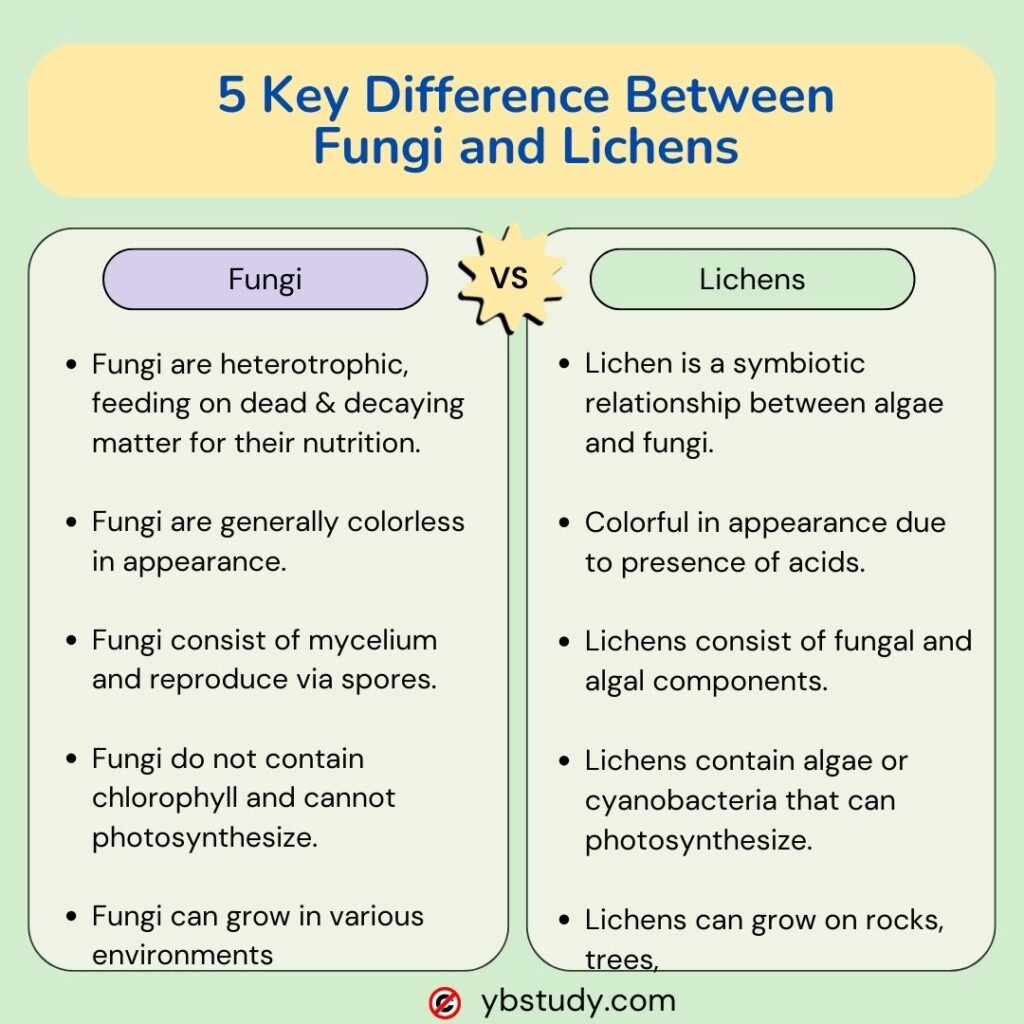Difference Between Fungi and Lichens: We are surrounded by many organisms, including fungi and lichens. Fungi can live independently, while lichens are made of fungi and algae living together in a symbiotic relationship. This guide will explore their definitions, structures, nutrition, growth conditions, reproduction, and importance.
Fungi are eukaryotic organisms, including yeasts, molds, and mushrooms, that are heterotrophic, meaning they obtain nutrients from other organisms or decaying matter.
A lichen is a composite organism formed by the symbiotic relationship between a fungus (mycobiont) and an alga or cyanobacterium (photobiont).
What are Fungi?
- Fungi is a diverse kingdom of eukaryotic organisms distinct from plants, animals, and bacteria. Common forms include yeasts, molds, truffles, and mushrooms.
- Most fungi are microscopic, composed of thread-like hyphae that form a mycelium, enabling them to absorb nutrients from various sources such as soil, water, decaying matter, and living organisms.
- Unlike plants, fungi do not perform photosynthesis; instead, they decompose organic material.
- Their cell walls are primarily made of chitin, a substance also found in the exoskeletons of insects and crustaceans.
- Fungi are classified into five primary phyla based on their reproductive methods: Chytridiomycota (chytrids), Zygomycota (conjugated fungi), Ascomycota (sac fungi), Basidiomycota (club fungi), and Glomeromycota.
- Chytrids are mostly unicellular and aquatic, often acting as parasites. Zygomycota typically feed on decaying materials. Ascomycota includes many edible species and some that produce toxic compounds. Basidiomycota encompasses familiar mushrooms and other large fungi. Glomeromycota form symbiotic relationships with plant roots. This classification underscores the ecological significance and biological diversity of fungi.
What are Lichens?
- Lichens are unique symbiotic organisms that result from a mutualistic association between fungi (mycobiont) and algae or cyanobacteria (phycobiont).
- This partnership allows lichens to thrive in diverse and often extreme environments, from arctic tundras to arid deserts.
- Lichens are classified into three primary types based on their morphology: crustose (crust-like and tightly attached to substrates), foliose (leaf-like with distinct lobes), and fruticose (shrubby or hair-like structures).
- These forms contribute to their adaptability and ecological roles. Notably, lichens are sensitive to environmental changes, making them valuable bioindicators for monitoring air quality and pollution levels.
- Reproduction in lichens occurs through both sexual and asexual means. Asexual reproduction involves structures like soredia and isidia, which facilitate dispersal and colonization.
- Ecologically, lichens play a pivotal role in soil formation by breaking down rocks and contributing organic matter, thus paving the way for other plant life. Additionally, certain lichen species are utilized in traditional medicine and dye production.
What is the Difference Between Fungi and Lichens PDF
| Fungi | Lichens |
|---|---|
| Fungi are heterotrophic organisms, feeding on dead and decaying matter for their nutrition. | Lichen is a symbiotic relationship between algae and fungi. |
| Fungi are a kingdom of spore-producing organisms. | Lichens are a symbiotic association between fungi and algae or cyanobacteria. |
| Fungi are generally colorless in appearance. | Lichens are colorful in appearance due to presence of acids. |
| Fungi consist of mycelium and reproduce via spores. | Lichens consist of fungal and algal (or cyanobacterial) components. |
| Fungi can be decomposers, parasites, or mutualists. | Lichens are primarily mutualistic, benefiting both partners. |
| Fungi usually grow in shady, dark and moist places. | Lichens grow independently, exposed to air and light. |
| Fungi do not contain chlorophyll and cannot photosynthesize. | Lichens contain algae or cyanobacteria that can photosynthesize. |
| Fungi can grow in various environments, including soil and decaying matter. | Lichens can grow on rocks, trees, and harsh environments like tundras and deserts. |
5 Key Differences Between Fungi and Lichens PDF

FAQs on Difference Between Fungi and Lichens
1. What are 5 difference between algae and fungi?
Answer: Algae belong to the kingdom Protista whereas, fungi belong to the kingdom Fungi. Algae are autotrophs, and Fungi are heterotrophs. Algae contain photosynthetic pigments. Fungi are capable of digesting non-living, organic material, and also absorbs simple nutrients by the fungal hyphae. Fungi commonly grow in shady, dark and moist places. Lichens grow freely when exposed to air and light.
2. What is the color of lichen?
Answer: The most common brightly colored pigment found in the cortex of lichens is usnic acid, which gives lichens a pale yellowish-green hue. This is the classic color of beard lichens, those stringy clumps that hang from branches. Pale yellow usnic acid is best at blocking short wavelengths of ultraviolet light.
3. Are fungi multicellular or unicellular?
Answer: Except for yeast, most fungi are multicellular creatures. A fungus' vegetative body can be unicellular or multicellular. Depending on the environment, dimorphic fungi can transition from a unicellular to a multicellular state. Yeasts are the common name for unicellular fungus.
4. What are the 5 main fungi?
Answer: Fungi contain five true phyla including Chytridiomycota, the Zygomycota, the Ascomycota, the Basidiomycota, and Glomeromycota.